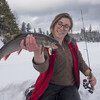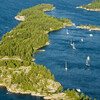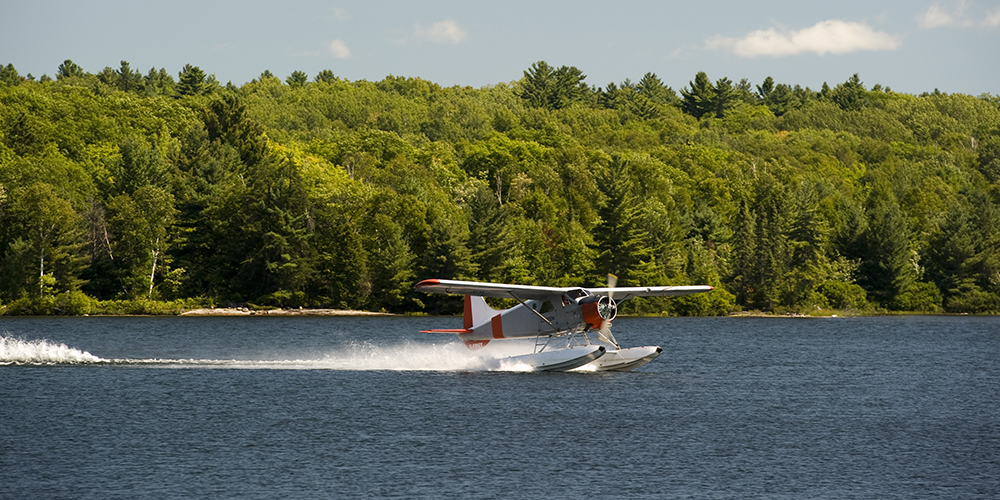
Lifelong Love of Northern Pike

Since I was a young boy, my affection for spending time on the water has been all-encompassing. Sure, activities such as swimming, canoeing, sailing, etc…had their special place. But nothing fascinated me as much as casting for fish…especially one species, Northern Pike! Their long slender bodies, lightning attacks, ferocious-looking face full of teeth and tendency of stealing bass and walleye off my line...these characteristics all contributed to my growing adulation for the water wolf of freshwater!

Through the years, I learned to catch pike on all types of bait and lures, discovered their favourite hunting locations in the differing seasons, and my competence at hooking and landing large northern pike grew exponentially. When I learned how to fly fish for trout, I often pondered whether it was possible to catch big pike on a fly. Then one year, I made two important discoveries that forever changed the way I angled for northern pike. The first happened when a friend lent me a copy of a book entitled “Pike On A Fly” by John Berry. In this book, John de-mystified the fly patterns needed, the leader and wire tippet requirements, rods and lines needed, and most importantly, he explained how to present your fly to trigger big pike into attacking your offerings.

Finally, I had the pieces of the puzzle needed to solve the riddle of how to properly seek and catch northern pike on a fly. My next big discovery to pike utopia was learning about a region of Ontario renowned for the quantity and size of pike it possessed….Algoma Country! This region of Northern Ontario offers incredible angling opportunities for pike in both rivers and lakes. Of equal importance, it provides opportunities to catch trophy pike at both fly-in destinations and drive-to locations, something you don’t see everywhere. In this article, I will detail important information gleaned from a life of hunting for pike, then discuss the basics of fly fishing equipment needed for this incredible species and the fly patterns that work best in Algoma Country.

So how do pike feed? Well, that’s a bit of a loaded question with respect to most other species. Big northern pike are generally solitary animals. They don’t school like other cool-water species such as smallmouth bass. Generally, outside of the spawn, larger pike are loners. This social behaviour can be a help and a hindrance to capturing food. Schooling fish have power in numbers and they can coordinate an attack on a shoal of baitfish as a group of individuals whereas northern pike must rely on their stealth and cunning to obtain their meals as solo hunters. Whereas schooling fish can actively hunt using their senses of sight, smell, sound and sense of vibrations, northern pike take a different tact. Relying on a combination of a vibration-sensitive lateral line running the length of the fish, and pores located along the lateral line from tail to jaw, the pike can “feel” the presence of other creatures in the water column – much like sonar on a whale or bat.
The information passed from the lateral line system to the brain immediately triggers the fight or flight response with the fight response resulting in an attack. Pike will lay in wait, in structures such as rock, wood, and weeds, seemingly dormant until that attack response is triggered. This plays into the fish’s metabolism by saving energy and maximizing the ingestion of much-needed protein. Search for a structure that would attract baitfish or is a travel way for prey and you’ll up your chances of passing your fly past an unassuming pike on point.

Pike behavior, the impact of weather patterns. Pike are a cool water species. They will migrate within the water column in constant search of their optimal water temperature. Generally, northern pike is most comfortable in the 64 – 70 degrees Fahrenheit temperature or 18-21 degrees Celsius. This means in the spring, anglers should search out the warmer parts of the system and as the summer creeps in, consider finding pike deeper or near cool water inflows. Day to day, usually the water temperatures don’t fluctuate much, however when cold fronts move in quickly, the changing barometric pressure influences pike behaviour.

Generally, swings in the barometer turn pike negative, in other words, a funk, they sulk, they find a haunt and wait it out. This doesn’t mean pike won’t feed; however, anglers will need to change their presentations to entice a strike from a funky northern. Slowing your presentation speed and downsizing your offering may be what it takes to get negative fish to feed. You can bet, however, that as the barometer stabilizes, the fish will slowly wake up and we often see a day or two after stabilization (conversely, just before the barometer drops) the fishing will be at its finest.

Fly fishing for pike requires heavier rods compared to those I used for trout in streams and lakes. Rods suitable for pike fly fishing generally range in weights from #7-10 with the most versatile rod being an 8- or a 9-weight. Both of these rods allow you to cast all except the largest pike flies and the 8-weight also has the added benefit of doubling as a rod suitable for bass or steelhead fly fishing. Fly fishing for pike requires heavier rods for several reasons and when choosing a rod you should consider factors such as the fly size, the wind, and weed conditions (cover) you are most likely to encounter on the lakes and rivers in Algoma Country.

The size of the fly is a major determinant of what rod to use. The larger, bulkier and more wind resistant the fly is the harder it will be to cast and therefore this necessitates more of your rod. Most Northern Pike flies will average 4-9 inches in length and are generally well-suitable for an 8-weight or 9-weight rod. If you are planning to use larger flies than that you are better off using a 9- or a 10-weight rod. Larger flies will also invariably also attract bigger fish which in some lakes and rivers in Algoma Country can reach weights of 20 pounds or more and a heavier rod will allow you to fight these larger trophy fish more efficiently. Pike are also often a weed-oriented species and a heavier rod allows you to fight the fish out of cover which could cause you to lose the fish. If there is plenty of nasty weed cover around, choose to go with a 9-weight to be able to better control the fish once it is hooked.
The next thing to consider is the wind. In heavier winds more is required of your rod to generate enough line speed to fire the fly to its designated target area. If you know that the waters you fish the most are prone to windy conditions, I would certainly suggest upsizing to a 9-weight rod. It is my favourite all-around fly rod.

The last item to consider is the leader and tippet setup to use. Whether with a floating line or sinking fly line, it is generally best to use shorter leaders. I like to use 4 to 6 feet of heavy mono (40-50 pound test) that is stiff and easily facilitates turning over large flies in the wind. Tied to your leader you want to attach 4 to 8 inches of 30-pound bite wire. You can attach this to the leader with a simple loop-to-loop connection. I’ve never lost a pike due to breaking off or cutting the wire leader with this setup.
There are a vast array of pike patterns out there with new ones coming out each season from the minds of savvy fly designers. However, there are some “tried and true” patterns that work particularly well in Algoma Country. Unquestionably my favourite topwater fly pattern for pike is the Weedman’s Slider designed by Stu Thompson. This fly is easy to cast, floats well and gives off a very enticing “wiggle” when retrieved. This fly is generally 6 to 9 inches in length. The best colours are black, orange/black and chartreuse. For streamers, I’ve tried a lot of great patterns and they all generally work well, especially the basic deceiver. However, a fly tier in Michigan came up with a super-deadly pattern for bass that turned out to work even better for Northern Pike. The Murdich Minnow is a great streamer pattern tied in white, black or perch colours. The large eye, body silhouette and rattle, all make this fly virtually irresistible to pike. Best of all, it is easy to cast and even easier to tie.

Today I am 62 years old and still get excited the night before going fishing, especially for Northern Pike. If you have that same feeling about this species or want to discover what the attraction is about this toothy fish, then I strongly recommend you explore the vast waters of Algoma Country. Whether with a fly rod or regular spinning gear, this region of Northern Ontario will offer you superlative pike fishing!
Recommended Articles

The Group of Seven in Algoma

9 Facts to Know about the Agawa Canyon Tour Train































